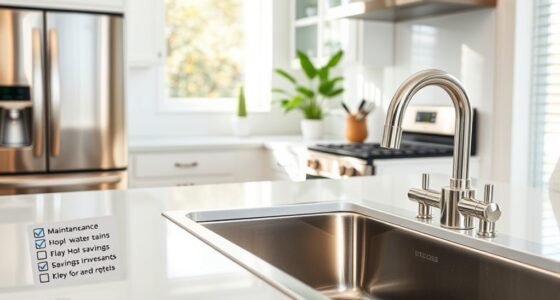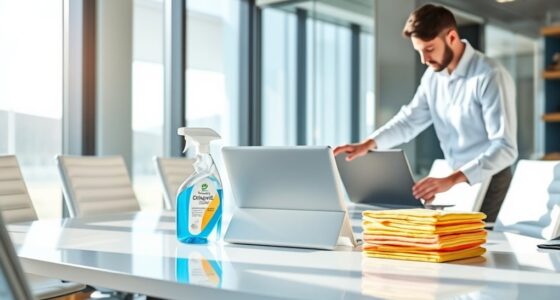To keep your restaurant kitchen up to code, create a detailed cleaning checklist focusing on daily tasks like sanitizing high-touch surfaces, food prep areas, and appliances. Incorporate weekly and monthly deep cleaning of ovens, refrigerators, and ventilation systems. Train staff on proper cleaning techniques and document all procedures to guarantee compliance. Regular maintenance prevents contamination, pest issues, and equipment failures, helping your kitchen stay safe and efficient. If you continue exploring, you’ll find tips to optimize your cleaning routine effectively.
Key Takeaways
- Develop a daily cleaning routine focusing on high-touch surfaces, food prep areas, and appliances to meet health standards.
- Use proper cleaning agents and sanitizers to eliminate germs and prevent contamination effectively.
- Conduct weekly deep cleaning of equipment like ovens, refrigerators, and exhaust hoods to maintain functionality and safety.
- Train staff regularly on cleaning techniques, sanitation procedures, and documentation to ensure compliance and consistency.
- Perform routine inspections and maintenance of kitchen equipment to prevent breakdowns, pest issues, and safety hazards.

Ever wonder how to keep your restaurant spotless and compliant with health standards? The key lies in a thorough cleaning routine that prioritizes food safety and equipment maintenance. When you consistently follow a detailed cleaning checklist, you not only ensure your establishment meets regulatory requirements but also create a safe environment for your staff and customers. Proper food safety practices begin with clean surfaces, sanitized utensils, and well-maintained equipment, all of which help prevent foodborne illnesses and contamination.
Maintaining a clean, compliant restaurant ensures safety, health, and top-quality service for staff and customers alike.
Start by focusing on your kitchen’s high-touch areas, such as countertops, cutting boards, and handles. These spots can harbor bacteria if not cleaned regularly. Using the right cleaning agents and sanitizers is essential to eliminate germs effectively. After each shift, guarantee all food prep surfaces are thoroughly scrubbed and sanitized, and don’t forget to clean appliances like ovens, refrigerators, and mixers. Equipment maintenance is critical here; regularly inspecting and servicing your machinery prevents breakdowns and keeps everything functioning at ideal standards. Well-maintained equipment not only improves safety but also enhances efficiency during busy hours.
Develop a routine that covers daily, weekly, and monthly cleaning tasks. Daily tasks include wiping down surfaces, sweeping floors, and sanitizing sinks and faucets. Weekly chores should involve deep cleaning ovens, refrigerators, and exhaust hoods, while monthly maintenance might include checking for leaks, inspecting electrical connections, and calibrating temperature controls. Staying consistent with this schedule ensures no area is neglected, reducing the risk of pests, mold, or bacteria buildup. Remember, neglecting equipment maintenance can lead to costly repairs and food safety hazards, so it’s vital to stay proactive.
Train your staff on proper cleaning techniques and the importance of food safety. Make sure everyone understands how to sanitize equipment correctly and why routine maintenance is necessary. Use checklists to track completed tasks and identify areas that need extra attention. Proper documentation helps you stay compliant with health inspections and provides proof that your team adheres to safety protocols.
Additionally, understanding the importance of equipment maintenance and its impact on overall food safety is essential for long-term success. Proper maintenance not only prevents breakdowns but also minimizes the risk of contamination from malfunctioning appliances. Proper documentation helps you stay compliant with health inspections and provides proof that your team adheres to safety protocols.
Ultimately, maintaining a spotless restaurant isn’t just about appearance; it’s about creating a safe, healthy environment for everyone. By emphasizing regular cleaning, diligent equipment maintenance, and staff training, you uphold high standards that protect your customers and your reputation. Incorporate these practices into your daily routine, and you’ll find that keeping your restaurant up to code becomes second nature. When you prioritize food safety and equipment care, you set your business up for success and ensure that every meal served is prepared in a clean, compliant space.
Frequently Asked Questions
How Often Should Deep Cleaning Be Scheduled in a Restaurant Kitchen?
You should schedule deep cleaning in your restaurant kitchen at least once every 3 to 6 months. This guarantees your cleaning equipment stays in top shape and prevents buildup of grease and grime. Coordinate staff scheduling to assign dedicated cleaning tasks during these periods. Regular deep cleaning maintains hygiene, keeps your kitchen up to code, and helps avoid costly repairs or inspections. Consistency is key for a safe, compliant, and efficient kitchen.
What Are the Best Eco-Friendly Cleaning Products for Restaurants?
When choosing eco-friendly cleaning products, you should look for biodegradable solutions and plant-based disinfectants. These products effectively clean without harming the environment or risking your staff’s health. You can find options like vinegar, lemon-based cleaners, and commercial biodegradable solutions that are safe for kitchen surfaces. By using these, you support sustainability and maintain a clean, safe restaurant kitchen that meets health standards.
How Can I Train Staff to Follow the Cleaning Checklist Consistently?
You can’t afford to let staff slip up on cleaning—imagine a kitchen turning into chaos! To prevent this, implement clear training modules that make expectations crystal clear. Hold regular staff accountability sessions, and use visual reminders to reinforce routines. Consistent coaching and feedback turn good intentions into habits. When your team understands the importance, they’ll follow the checklist diligently, keeping your restaurant spotless and compliant every single day.
What Are Common Overlooked Areas in Restaurant Cleaning Routines?
You might overlook areas like kitchen equipment and ventilation systems during cleaning. These spots often accumulate grease, dust, and debris, which can impact hygiene and safety. Make certain you regularly clean and inspect appliances, surfaces, and exhaust vents. Incorporate these into your routine to ensure compliance and maintain a healthy environment. Consistent attention to these overlooked areas helps prevent pest issues, odors, and potential violations.
How Do I Handle Cleaning During Busy Restaurant Hours?
Handling cleaning during busy hours might seem impossible, but irony strikes—it’s actually essential for smooth operations. You should prioritize staff communication, so everyone knows their roles, and use sharp time management to clean efficiently without disrupting service. Quick wipe-downs between tables or during downtime keep the kitchen spotless. Remember, staying organized and communicating well turns chaos into a clean, seamless experience, even at the busiest moments.
Conclusion
A spotless kitchen keeps your restaurant compliant and your customers happy. While a sparkling surface invites trust, neglect can lead to costly violations. Remember, your attention to cleanliness isn’t just about appearances—it’s about safety and reputation. So, stay diligent with your cleaning checklist; after all, a well-maintained kitchen is the secret ingredient to long-term success and peace of mind. Keep it clean, keep it safe.










